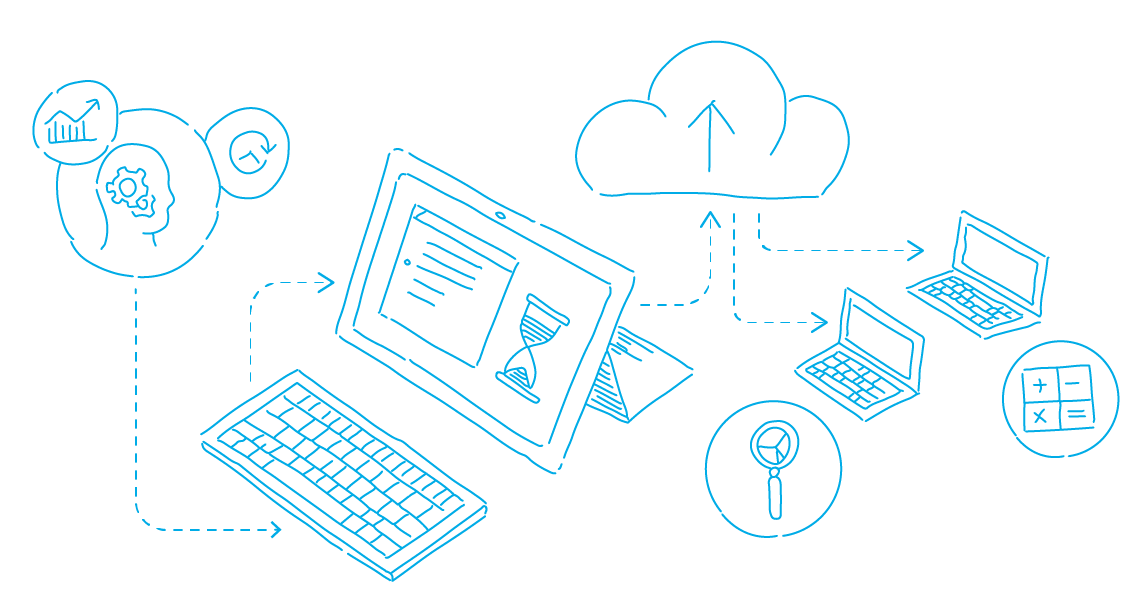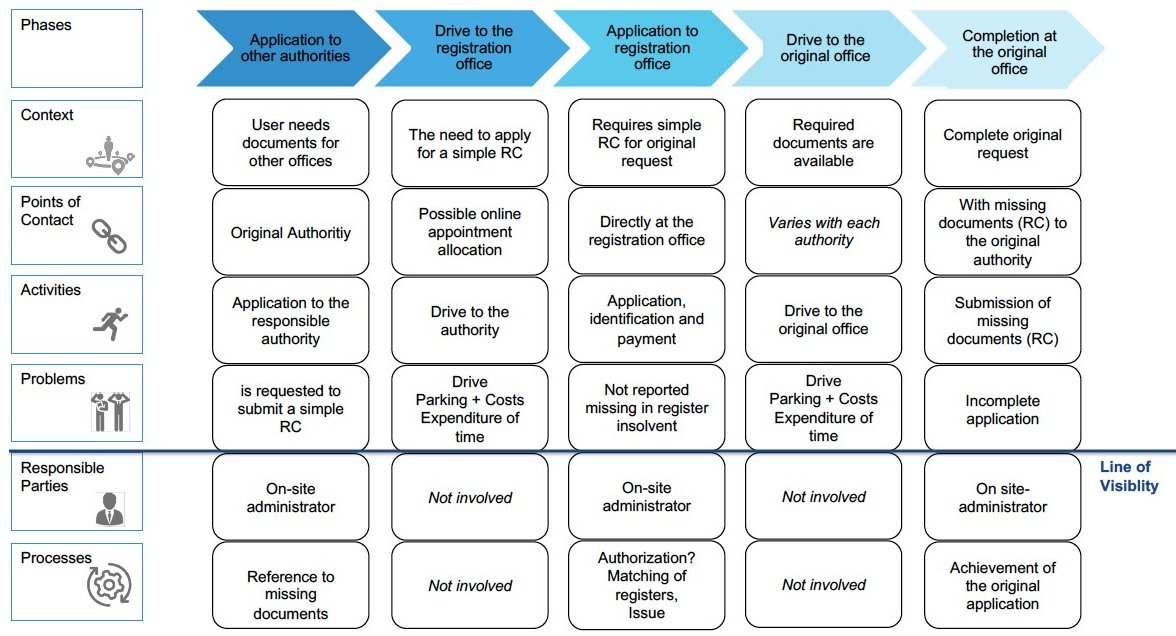
Digitalization of the Simple Registration Certificate
Development of a Prototype - Laura Csulits
Summary
In order to address the challenges of digitalization, public administrations need to develop new strategies. In the following, a possible strategy to meet the challenge will be identified and explained – namely the establishment of a prototype for new online processes in administration, which puts an emphasis on taking into account the user perspective. This will be applied concretely to the digitalization process of the simple registration certificate in cooperation with the city of Ulm.
By means of expert and user interviews, it was possible to identify weak points of the current process and suggestions for improvement. Based on the conducted interviews, we came to the conclusion that the process in its current state is running satisfactorily for the users. Nonetheless, an online application was addressed and favored by all citizens. The main arguments for the online process are the flexible application, selection of different languages, but also the simplification for further usage. On this basis, it was possible to create a prototype for a suitable online process.
Context
Public administrations often neglect the intuition, the subjective assessment and the implicit knowledge of citizens when thinking about adiminstrative processes. This leads to a divergence between the perspective of the administration on the one hand and the perspective of the citizens as users on the other hand. In order to successfully implement the digitalization of administrative processes, it is therefore important to put on the so-called "user glasses". Especially when the goal is to develop effective and user-friendly digital services, it is important to include the citizens' point of view in order to create a prototype design for, by and with the users (Jaeger & Bertot, 2010). A prototype is the representation of a possible implementation of digitalization in this context.
In the following, the course of a prototypical design in public administration is sketched exemplary. At the beginning, basic information about the simple registration certificate and the procedure for obtaining information is shown. Subsequently, problems will be discussed from the user's perspective in order to focus on the implementation afterwards.
Methodology
Step 1- Collection of basic information about the process of the simple registration certificate in Ulm
At the beginning it is important to get an overview of the current state of the process. For this purpose, we used the method of expert interviews. Through an interview with the head of department of the registration and passport authority, we were able to, for example, collect information about the application process and the arising costs. We were also able to use the interview to create a flowchart and a profile about the process.
During the expert interview it became clear that the simple registration certificate is only a small part of a larger administrative process. The simple registration certificate provides information about the current registration status of a person and usually contains the family name and first name, as well as the current address of the applicant. It is needed, for instance, for the employment office, the consulate or the bank. It thus became clear that this is a process of co-production. Hence, the various offices/authorities are indirectly connected. After first receiving the simple registration certificate, the applicant will always need to go to other offices or authorities. Therefore, an online and digitally available document could be useful, as it can shorten the time required for the larger administrative process.
The next step describes how we have created an evaluation of the current process through user interviews. The emphasis will be on the user's point of view. In general, user interviews are extremely important, as it is possible to find out who the users of the process are and what expectations they have (Osborne, Radnor & Nasi, 2012). The interviews also form the basis for the creation of the prototype.
Step 2- Identification of problems from the user's internal perspective
By means of the user interviews we were able to determine a general satisfaction with the current process. Nevertheless, all users have mentioned on their own initiative the possibility of an online application to improve the service.

Since the registration certificate, as mentioned above, is only a small part of a larger administrative process, a so-called user journey (Figure 1) assists to make the individual steps (before, during and after applying for the registration certificate) clearer (before, during and after applying for the registration certificate). Furthermore, a distinction is made between the personal experiences of users (area above the line of visibility) and processes in the administration itself (area below the line of visibility). Summarizing the above, it can be said that the application of the user journey allows the data collected in the user interviews to be grouped into five concrete steps.
Step 3- Concrete implementation of the digital prototype
In the further course, especially with regard to the prototype, it is important to concretize the information received with regard to its feasibility. This includes considerations about the most user-friendly implementation, as well as considerations about the importance of each individual aspect.
The first important practical consideration related to the simple registration certificate is the question of the registration of the users. Here the option of setting up a service account via the personnel number can be weighed against logging in via the name and date of birth. The protection of users data plays an important role here. A possible problem is a non-existent personnel number. If this is the case, citizens are only entitled to apply for the registration certificate online if the personnel number has been determined by another authority.
As the process progresses, users must be able to either choose a specific area (registration, passwords, waste disposal companies, etc.) or alternatively a window with all available online services could be opened in which the users can select the required service.
Since the users themselves may not know what type of registration certificate (simple/extended) is required, the prototype must also provide help here. It can be guaranteed by inserting the question for which office the registration certificate is required into the process.
The simple registration certificate can also be requested by a third party, a so-called supervisor. The databases of the Social Welfare Office must be accessed in order to verify the number of people supervised. In addition, a permanent synchronization of the databases must also be ensured.
The user interviews also revealed that the possibility of exemption from costs exists when the registration certificate is required for the employment office. Thus, it must be ensured that it is possible to distinguish between an application for the job center and for other offices. One way to approach this issue is to work with a code or use another verification method of the employment office.
One of the most important goals of the online application is to save time. Hence, it is important to consider how the document can be issued. One option would be the immediate download of a PDF file, which could be forwarded to the original authority via e-mail. Furthermore, there are various different alternatives with regard to the payment process: the SEPA direct debit procedure, PayPal, as well as invoices are possible options. One problem would be the possible insolvency of the users, which would lead to a refusal to issue the registration certificate.
In order for users to be able to check or change their data at any time, there should be a permanent back option as well as the possibility of an overview of the data before handing in the final application.
Approach/Results
By means of the user interviews, we came to the conclusion that time savings, achieved by an online application, play a particularly important role. Working people argue with the poorly adapted opening hours of public offices. A visit to the authority is associated with the drive, the waiting times and the duration of the issuing process. Particularly in a process such as the simple registration certificate, several visits to the authorities are connected. By applying online, it is possible to save users one expense and give them more time for other things. A further problem is the language barrier that can be circumvented by an online application – through selecting the language. Since there is also the possibility that supervisors have to apply for a registration certificate for third parties, digitalization would be advantageous as it would save travel and time costs here too.
Practical Implications
When considering the process of the simple registration certificate, we noticed four aspects that a city like Ulm should consider in order to make the digitalization process as user-friendly and successful as possible:
1) When using interviews with experts and users, one has to take care on making the process as user-friendly as possible. Basic questions regarding verification, cost settlement, exhibition, etc. must be clarified.
2) Care must be taken to counteract bad investments. This can be guaranteed by involving the users in the development process.
3) In addition, the administration should make use of the possibility to react to the assessments of the users using their processes and modify the prototype over a period of time until a final satisfactory process for the users emerges.
4) In processes of co-production, public administrations should also always ensure that all offices are involved from the outset in order to ensure effective implementation.
Files

Laura Csulits:
From 2016 to 2020 Laura Csulits studied Politics and Public Administration at the University of Constance, focusing on management and public administration. Since her bachelor's degree, Laura Csulits has been working as the personal assistant of a member of the Baden-Württemberg state parliament.
